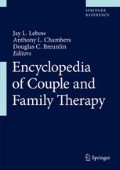Access this chapter
Tax calculation will be finalised at checkout
Purchases are for personal use only
References
Allman, L. (1982). The aesthetic preference: Overcoming the pragmatic error. Family Process, 21(1), 43–56. https://doi.org/10.1111/j.1545-5300.1982.00043.x.
Anderson, H. (1997). Conversation, language, and possibilities: A postmodern approach to therapy. New York: Basic Books.
Anderson, H. (2003). Some notes on listening, hearing and speaking and the relationship to dialogue. Paper presented at the Eighth Annual Open Dialogue Conference: What is Helpful in Treatment Dialogue? Tornio, Finland. Retrieved from http://harleneanderson.org/articles/newbatch/Dialogue-listeningspeakinghearing.pdf
Anderson, H., & Goolishian, H. (1988). Human systems as linguistic systems: Evolving ideas about the implications for theory and practice. Family Process, 27, 371–393.
Bakhtin, M. M. (1981). The dialogic imagination: Four essays. Austin: University of Texas Press. Kindle Edition.
Bauman, Z. (2007). Liquid times: Living in an age of uncertainty. Malden, MA: Polity Press. Kindle Edition.
Bava, S. (2016). Play-oriented pedagogy: Liberating emergence and uncertainty in couples and family therapy training. Manuscript submitted for publication.
Brown, S. (2010). Play: How it shapes the brain, opens the imagination, and invigorates the soul. New York: Avery, The Penguin Group.
Gergen, K. J. (1999). An invitation to social construction. Thousand Oaks: Sage.
Gergen, K. (2009). Relational being: Beyond self and community. New York: Oxford University Press. Kindle Edition. Retrieved from amazon.com
Hoffman, L. (1998). Setting aside the model in family therapy. Journal of Marital and Family Therapy, 24(2), 145–156.
Imber-Black, E. (2014). Eschewing certainties the creation of family therapists in the 21st century. Family Process, 53, 371–379.
Keith, D. (2014). Continuing the experiential approach of Carl Whitaker. Phoenix: Zeig, Tucker & Thiesen. Kindle Edition. Retrieved from amazon.com
Levin, S., & Bava, S. (2012). Collaborative therapy: Performing reflective and dialogic relationships. In A. Lock & T. Strong (Eds.), Discursive perspectives in therapeutic practice (pp. 127–142). Oxford: Oxford University Press.
McNamee, S. (2004). Therapy as social construction. In T. Strong & D. Pare (Eds.), Furthering talk: Advances in the discursive therapies. New York: Kluwer Academic/Plenum Press.
Montuori, A. (1992). Creativity, chaos, and self-renewal in human systems. World Futures, 35, 193–209.
Montuori, A., & Purser, R. (2011). Social creativity: The challenge of complexity. Retrieved from https://www.researchgate.net/publication/267834184
Pearce, B. (2007). Making social worlds: A communication perspective. Malden: Blackwell Publishing.
Poynton, R. (2008). Everything’s an offer: How to do more with less. Portland: On Your Feet.
Shotter, J. (2011). The dance of Rhetoric: Dialogic selves and spontaneously responsive expressions. In C. Meyer & F. Girke (Eds.), The rhetorical emergence of culture (pp. 37–51). New York/London: Berghahn Books.
Author information
Authors and Affiliations
Corresponding author
Editor information
Editors and Affiliations
Section Editor information
Rights and permissions
Copyright information
© 2019 Springer Nature Switzerland AG
About this entry
Cite this entry
Bava, S. (2019). Creativity in Couple and Family Therapy. In: Lebow, J.L., Chambers, A.L., Breunlin, D.C. (eds) Encyclopedia of Couple and Family Therapy. Springer, Cham. https://doi.org/10.1007/978-3-319-49425-8_226
Download citation
DOI: https://doi.org/10.1007/978-3-319-49425-8_226
Published:
Publisher Name: Springer, Cham
Print ISBN: 978-3-319-49423-4
Online ISBN: 978-3-319-49425-8
eBook Packages: Behavioral Science and PsychologyReference Module Humanities and Social SciencesReference Module Business, Economics and Social Sciences

